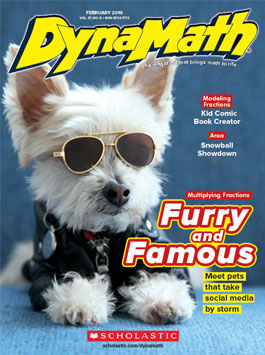Today’s teaching tips come from our very own Melinda Villalovos, Arizona math coach and all-around DynaMath superstar. In addition to helping almost 800 math teachers in the Deer Valley Unified School District (servicing about 25,000 elementary- and middle-school students!), Villalovos helps us develop lesson plans and other materials for our magazine. Let’s just say her help really “adds up!”

What to do with a DynaDash?
4 ideas for differentiation with our fluency-building skills sheets
Developing math fluency doesn’t always mean doing problems quickly
When it comes to improving students’ math fluency, there are a number of ways you could do it. Villalovos’s approach is for students to do fewer problems spend more time on each one. That way, she can incorporate hands-on tools or manipulatives, model drawings, and student discourse into each problem. The goal is for students to walk away with a deeper understanding of the math content they’re learning.
Our DynaDashes are short, fluency-building activities for grades 3, 4, and 5 in our Teacher’s Guide. (Download a free sample on our Pinterest page).
Villalovos is adept at adjusting math activities such as these for students at different skill levels. Here’s how Villalovos suggests differentiating DynaDashes:
1. Highlight what they know
Instead writing down the answers, have students use a highlighter or circle the problems they know how to compute mentally or fluently. (This is great for students that really struggle with processing and automaticity.)
2. Solve one problem at a time
Have teachers select a handful of DynaDash problems, and assign them to students to solve one at a time. Students can hold up their solutions on their whiteboard to share their work, and continue onto the next problem.
3. Take away the time limit
Instead of the 60-second time limit, try providing 5 minutes for students to solve the problems, or don’t give them a time limit at all. Then they have ample time to share and discuss their work with partners or a group.
4. Provide some prep time
Give students a few minutes to look over the DynaDashes before you begin. Then have them solve the problems within a certain time frame.
Like so many other teachers, Villalovos is full of ideas. If you have one, please share it! You can shoot me an email.
Want more elementary math education tips and news? Check out Scholastic's archive.
Alexa Kurzius (@ackurzius) is the Senior Associate Editor of DynaMath, one of Scholastic’s elementary STEM magazines.
Recent Posts
-
July 7, 2021
SEL in the Math Classroom: Strategies for Resilience
-
January 30, 2019
Make the Most of DynaMath–With Google Classroom!
-
January 8, 2019
Easy Classroom Updates for 2020
-
December 3, 2019
4 Fun Ways to Use Math Around the Holidays
-
September 10, 2019
Fun Math Icebreaker Activity
Exciting ideas and fun teaching strategies for using DynaMath in 3rd, 4th, and 5th grade math classrooms


